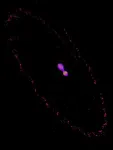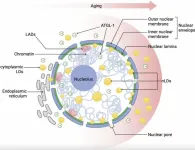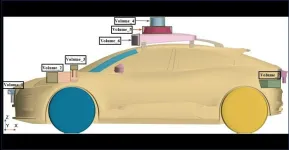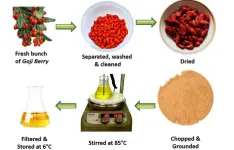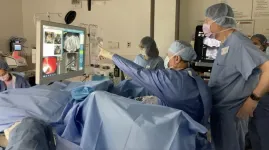(Press-News.org) Concussions and repetitive head trauma in sports like football and boxing, once accepted as an unpleasant consequence of intense athletic competition, are now recognized as serious health threats. Of particular concern is the connection between head injuries and neurodegenerative diseases such as chronic traumatic encephalopathy, Alzheimer’s disease, and Parkinson’s disease, prompting sports governing bodies to adjust protective equipment and rules of play to minimize the risk.
Researchers at Tufts University and Oxford University have now uncovered mechanisms that may connect the dots between trauma event and the emergence of disease, pointing to latent viruses lurking in most of our brains that may be activated by the jolt, leading to inflammation and accumulating damage that can occur over the ensuing months and years. The results suggest the use of antiviral drugs as potential early preventive treatments post-head injury. The findings are published in a study in Science Signaling.
The microbiome—which includes many hundreds of bacterial species that inhabit our bodies—provides aid in digestion, immune system development, and protection against harmful pathogens. But the microbiome also includes dozens of viruses that swarm within our bodies at any given time. Some of these can be potentially harmful, but simply lie dormant within our cells. Herpes simplex virus 1 (HSV-1), found in over 80% of people, and varicella-zoster virus, found in 95% of people, are known to make their way into the brain and sleep within our neurons and glial cells.
Dana Cairns, research associate in the Department of Biomedical Engineering at Tufts University and lead author of the study, had found evidence in earlier studies suggesting that activation of HSV-1 from its dormant state triggers the signature symptoms of Alzheimer’s disease in lab models of brain tissue—amyloid plaques, neuronal loss, inflammations, and diminished neural network functionality.
“In that study, another virus—varicella—created the inflammatory conditions that activated HSV-1,” said Cairns. “We thought, what would happen if we subjected the brain tissue model to a physical disruption, something akin to a concussion? Would HSV-1 wake up and start the process of neurodegeneration?”
The link between HSV-1 and Alzheimer’s disease was first suggested by co-author Ruth Itzhaki, Visiting Professorial Fellow at Oxford University, who over 30 years ago identified the virus in a high proportion of brains from the elderly population. Her subsequent studies suggested that the virus can be reactivated in the brain from a latent state by events such as stress or immunosuppression, ultimately leading to neuronal damage. In the current study, the researchers used a lab model that reconstructs the environment of the brain to better understand how concussions may set off the first stages of virus reactivation and neurodegeneration.
The brain tissue model consists of a 6mm wide donut-shaped sponge-like material made of silk protein and collagen, suffused with neural stem cells, which are then coaxed into mature neurons, growing axons and dendrite extensions and forming a network. Glial cells also emerge from the stem cells to help mimic the brain environment and nurture the neurons. The neurons communicate with each other through their extensions similarly to how they would communicate in a brain. And just like cells in the brain, they can carry within them the DNA of dormant HSV-1 virus.
After enclosing the brain-like tissue in a cylinder and giving it a sudden jolt atop a piston, mimicking a concussion, Cairns examined the tissue under the microscope over time. Some of the tissue models had neurons with HSV-1, and some were virus-free. After the controlled blows, she observed that the infected cells showed re-activation of the virus, and shortly after that the signature markers of Alzheimer’s disease, including amyloid plaques, p-tau (a protein that creates fiber-like “tangles” in the brain), inflammation, dying neurons, and a proliferation of glial cells called gliosis.
More strikes with the pistons on the tissue models mimicking repetitive head injuries led to the same reactions, which were even more severe. Meanwhile, the cells without HSV-1 showed some gliosis, but none of the other markers of Alzheimer’s disease.
The results were a strong indicator that athletes suffering concussions could be triggering reactivation of latent infections in the brain that can lead to Alzheimer’s disease. Epidemiological studies have shown that multiple blows to the head can lead to doubling or even greater chances of having a neurodegenerative condition months or years down the line.
“This opens the question as to whether antiviral drugs or anti-inflammatory agents might be useful as early preventive treatments after head trauma to stop HSV-1 activation in its tracks, and lower the risk of Alzheimer’s disease,” said Cairns.
The problem goes far beyond the concerns for athletes. Traumatic brain injury is one of the most common causes of disability and death in adults, affecting about 69 million people worldwide each year, at an economic cost estimated at $400 billion annually.
“The brain tissue model takes us to another level in investigating these connections between injury, infection, and Alzheimer’s disease,” said David Kaplan, Stern Family Endowed Professor of Engineering at Tufts. “We can re-create normal tissue environments that look like the inside of a brain, track viruses, plaques, proteins, genetic activity, inflammation and even measure the level of signaling between neurons. There is a lot of epidemiological evidence about environmental and other links to the risk of Alzheimer’s. The tissue model will help us put that information on a mechanistic footing and provide a starting point for testing new drugs.”
END
Study shows head trauma may activate latent viruses, leading to neurodegeneration
Researchers at Tufts University suggest results may lead to preventive strategies using antiviral drugs
2025-01-07
ELSE PRESS RELEASES FROM THIS DATE:
Advancements in neural implant research enhance durability
2025-01-07
Crucial research on brain diseases
Neural implants are crucial in order to study the brain and develop treatments for patients with diseases like Parkinson's or clinical depression. Neural implants electrically stimulate, block, or record signals from neurons or neural networks in the brain. For study and treatment, and specifically for chronic use, these neural implants must be durable.
"Miniaturized neural implants have enormous potential to transform healthcare, but their long-term stability in the body ...
SwRI models Pluto-Charon formation scenario that mimics Earth-Moon system
2025-01-07
SAN ANTONIO — January 7, 2025 —A NASA postdoctoral researcher at Southwest Research Institute has used advanced models that indicate that the formation of Pluto and Charon may parallel that of the Earth-Moon system. Both systems include a moon that is a large fraction of the size of the main body, unlike other moons in the solar system. The scenario also could support Pluto’s active geology and possible subsurface ocean, despite its location at the frozen edge of the solar system.
“We ...
Researchers identify public policies that work to prevent suicide
2025-01-07
An analysis led by New York University researchers determines which public policies effectively prevent suicide deaths in the United States. But it’s not just policies that limit firearms and expand access to health care—many economic and social policies that are not explicitly focused on mental health can also prevent suicide, according to their article published in the Annual Review of Public Health.
“Most of the policies that demonstrate evidence do not mention suicide and were not passed to prevent ...
Korea University College of Medicine and Yale Univeristy co-host forum on Advancing Healthcare through Data and AI Innovations
2025-01-07
Korea University College of Medicine and Yale Univeristy Co-Host Forum
on Advancing Healthcare through Data and AI Innovations
On October 2nd (Wednesday), Korea University College of Medicine (Dean: Pyun Sung-Bom) hosted a forum titled “Advancing Healthcare through Innovations in Data and AI in Clinical Informatics and Natural Language Processing” in the 6th-floor lecture hall of the First Medical Building.
As part of Korea University’s 120th-anniversary celebration, this annual joint forum with Yale University has been held since 2023. This year’s ...
Nuclear lipid droplets: Key regulators of aging and nuclear homeostasis
2025-01-07
“A consistent feature of aging across diverse species is the progressive accumulation of lipid droplets (nLDs) within the nuclear compartment, which disrupts nuclear architecture and functionality.”
BUFFALO, NY- January 7, 2025 – A new research perspective was published in Aging (listed by MEDLINE/PubMed as “Aging (Albany NY)” and “Aging-US” by Web of Science) Volume 16, Issue 22 on December 9, 2024, entitled “Nuclear lipid droplets: a novel regulator of nuclear homeostasis ...
Driving autonomous vehicles to a more efficient future
2025-01-07
WASHINGTON, Jan. 7, 2025 – Thanks to the rapid progress of information technology and artificial intelligence, autonomous vehicles (AVs) have been taking off. In fact, AV technology is now advanced enough that the vehicles are being used for logistics delivery and low-speed public transportation.
While most research has focused on control algorithms to heighten safety, less attention has been directed at improving aerodynamic performance, which is essential for lowering energy consumption and extending driving range. As a result, aerodynamic drag issues have ...
Severe maternal morbidity among pregnant people with opioid use disorder enrolled in Medicaid
2025-01-07
About The Study: This cross-sectional study of pregnant people enrolled in Medicaid found that the rate of opioid use disorder among this group was more than twice as high as previous estimates. Pregnant people with opioid use disorder face a disproportionately high risk of severe maternal morbidity, particularly those who enroll in Medicaid later in pregnancy. Targeted interventions that facilitate early Medicaid enrollment and coverage continuity may be needed to reduce the burden of adverse outcomes in this group.
Corresponding ...
Macronutrients in human milk exposed to antidepressant and anti-inflammatory medications
2025-01-07
About The Study: In this cross-sectional study, some maternal medications were associated with lower levels of protein and fat in milk, which could impose health risks for breastfed infants. Other factors that could influence macronutrient levels need to be clarified before the clinical implications of these findings can be confirmed.
Corresponding Author: To contact the corresponding author, Essi Whaites Heinonen, MD, PhD, email essi.heinonen@ki.se.
To access the embargoed study: Visit our For The Media website at this link https://media.jamanetwork.com/
(doi:10.1001/jamanetworkopen.2024.53332)
Editor’s Note: Please ...
Exploring the eco-friendly future of antibiotic particles
2025-01-07
WASHINGTON, Jan. 7, 2025 – As the search for sustainability permeates all fields, researchers are turning to a unique organic source for creating antibacterial silver nanoparticles (Ag-NPs) – the humble goji berry.
Goji berries are a ubiquitous superfood known for a multitude of health benefits, including their antibiotic properties. In research published in AIP Advances, by AIP Publishing, researcher Kamran Alam from Sapienza University of Rome along with others from NED University of Engineering and Technology and King Saud University found an effective way to harvest ...
Can you steam away prostate cancer?
2025-01-07
LOS ANGELES — Steam eliminates wrinkles and germs, but can it destroy cancer cells too?
Keck Medicine of USC is participating in a national, multisite clinical trial examining if a water vapor system that uses small, targeted amounts of steam to kill cancer cells is a safe and effective treatment for prostate cancer.
Researchers hope that steam may offer patients a less invasive way of controlling or curing cancer than currently exists.
“The most common therapies for prostate cancer often cause life-altering side effects, and we are investigating if this new treatment may not only treat the cancer, ...
LAST 30 PRESS RELEASES:
NTP-enhanced lattice oxygen activation in Ce-Co catalysts for low-temperature soot combustion
Synergistic interface engineering in Cu-Zn-Ce catalysts for efficient CO2 hydrogenation to methanol
COVID-19 leaves a lasting mark on the human brain
Scientists use ultrasound to soften and treat cancer tumors without damaging healthy tissue
Community swimming program for Black youth boosts skills, sense of belonging, study finds
Specific depressive symptoms in midlife linked to increased dementia risk
An ‘illuminating’ design sheds light on cholesterol
Who is more likely to get long COVID?
Study showcases resilience and rapid growth of “living rocks”
Naval Research Lab diver earns Office of Naval Research 2025 Sailor of the Year
New Mayo-led study establishes practical definition for rapidly progressive dementia
Fossil fuel industry’s “climate false solutions” reinforce its power and aggravate environmental injustice
Researchers reveal bias in a widely used measure of algorithm performance
Alcohol causes cancer. A study from IOCB Prague confirms damage to DNA and shows how cells defend against it
Hidden viruses in wastewater treatment may shape public health risks, study finds
Unlock the power of nature: how biomass can transform climate mitigation
Biochar reshapes hidden soil microbes that capture carbon dioxide in farmland
Reducing saturated fat intake shows mortality benefit, but only in high-risk individuals
Manta rays create mobile ecosystems, study finds
Study: Mixed results in using lipoic acid to treat progressive multiple sclerosis
Norbert Holtkamp appointed director of Fermi National Accelerator Laboratory
New agentic AI platform accelerates advanced optics design
Biologists discover neurons use physical signals — not electricity — to stabilize communication
Researchers discover that a hormone can access the brain by hitchhiking
University of Oklahoma researcher awarded funding to pursue AI-powered material design
Exploring how the visual system recovers following injury
Support for parents with infants at pediatric check-ups leads to better reading and math skills in elementary school
Kids’ behavioral health is a growing share of family health costs
Day & night: Cancer disrupts the brain’s natural rhythm
COVID-19 vaccination significantly reduces risk to pregnant women and baby
[Press-News.org] Study shows head trauma may activate latent viruses, leading to neurodegenerationResearchers at Tufts University suggest results may lead to preventive strategies using antiviral drugs


